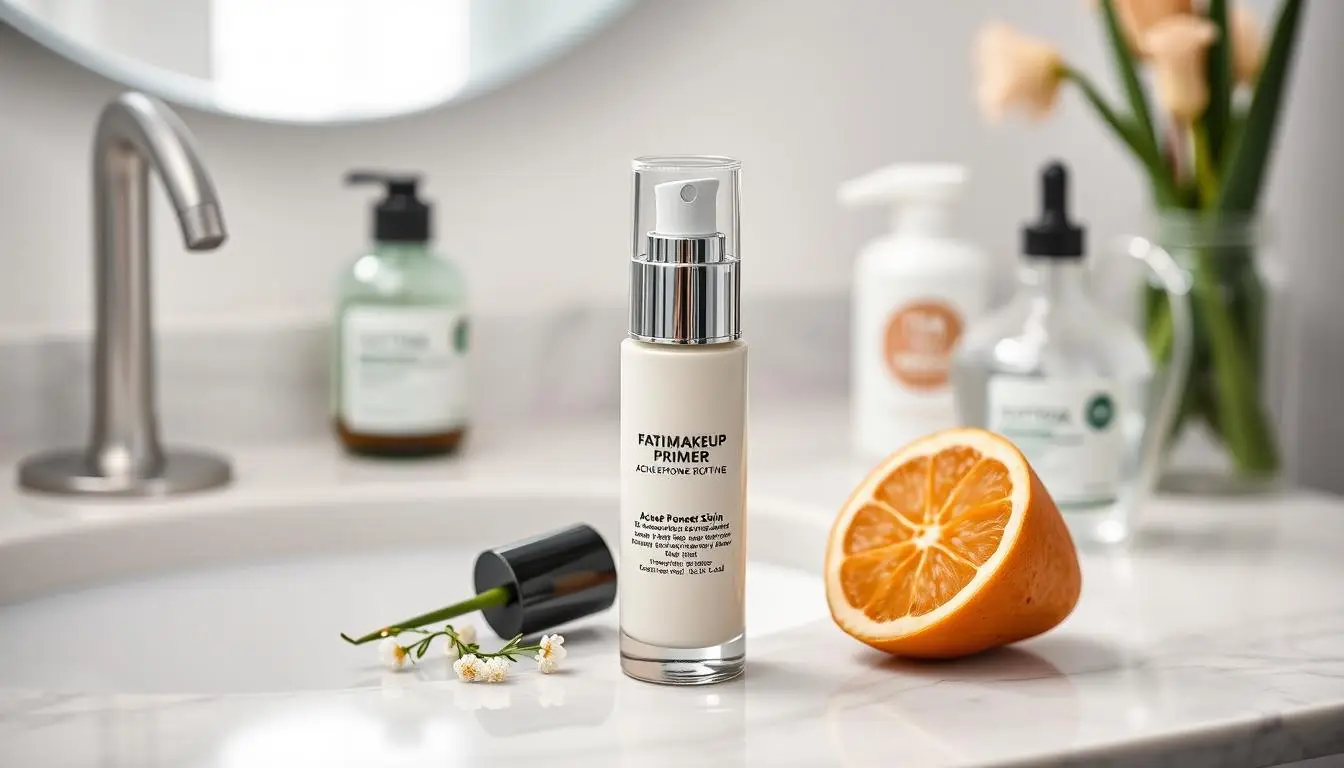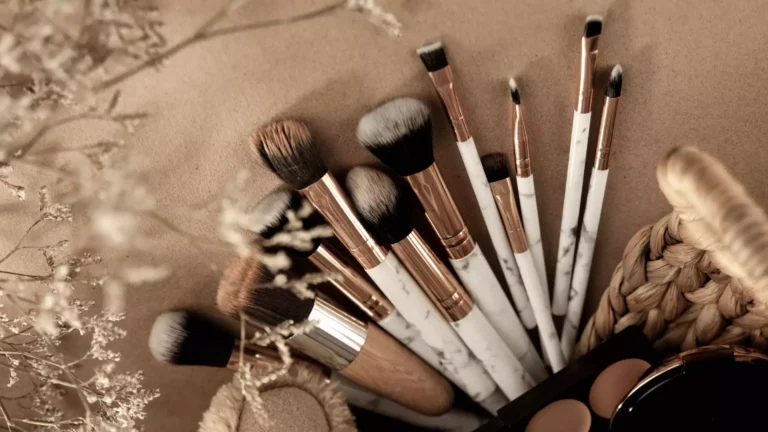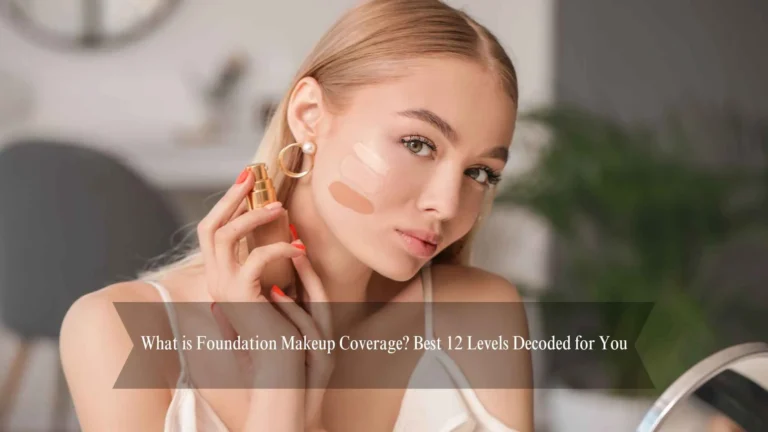Should I Use Makeup Primer If I Have Acne?
Table of Contents
Using makeup primer on acne-prone skin is a big decision. Many people with acne wonder if they should use primer. The right primer can make your makeup look better, but the wrong one can make acne worse.

Choosing the right primer is key. If you have acne, pick a primer that doesn’t clog pores. So, yes, you can use makeup primer with caution. The right primer can help your skin look smooth and flawless without making your acne worse.
Key Takeaways
- Consider the potential impact of makeup primer on your acne-prone skin
- Choose a non-comedogenic and oil-free primer to minimize the risk of clogged pores
- Using the right makeup primer for acne prone skin can help create a smooth canvas for your makeup
- Select a primer that is suitable for your skin type and concerns
- Apply primer correctly to avoid exacerbating acne
Understanding Makeup Primers and Their Relationship with Acne
Makeup primers are key in many beauty routines. But, for those with acne, it’s vital to know how they work. A good best makeup primer for acne can make your skin smooth for makeup. Yet, picking the right one is crucial to avoid making acne worse.
Looking for an acne-friendly makeup primer? Consider a few things. It should be non-comedogenic to avoid clogging pores. Also, it should be fragrance-free to lower irritation risk. Some primers even have ingredients that calm the skin, reducing redness and swelling.
What is makeup primer?
A makeup primer is applied before makeup to smooth out your skin. It helps your makeup last longer, keeps oiliness at bay, and hides pores.
How primers interact with acne-prone skin
Using the right best makeup primer for acne can make acne less noticeable and prevent new breakouts. But, the wrong primer can clog pores and worsen acne. Always choose a primer labeled “non-comedogenic” or “oil-free” to avoid clogging pores.
Common ingredients in makeup primers
Makeup primers often have silicones for smooth skin and glycerin for moisture. When picking an acne-friendly makeup primer, look for gentle, non-irritating ingredients.
Understanding makeup primers and their impact on acne-prone skin helps you make better choices. Whether you’re searching for a best makeup primer for acne or an acne-friendly makeup primer, there are many options. These can help you get a smooth, flawless look.
| Primer Type | Benefits | Drawbacks |
|---|---|---|
| Non-comedogenic | Won’t clog pores, reduces acne | May not provide adequate moisture |
| Oil-free | Won’t exacerbate oily skin, reduces shine | May not provide adequate hydration |
| Hydrating | Provides long-lasting hydration, soothes dry skin | May clog pores if not chosen carefully |
The Benefits of Using Primer on Acne-Prone Skin
Makeup primer offers many benefits for those with acne-prone skin. It makes your skin smooth for makeup, hides pores, and controls shine. It also helps in reducing acne by acting as a barrier between your skin and makeup.
Key benefits include:
- Reduced appearance of pores, giving the skin a smoother texture
- Improved makeup application and longevity
- Controlled shine, reducing the appearance of oily skin
- A barrier between the skin and makeup, helping to prevent clogged pores and reduce acne
When picking a primer, choose one that’s non-comedogenic and oil-free. These types are less likely to clog pores and worsen acne. Adding a primer to your skincare routine helps create a smooth base for makeup. It also aids in reducing acne and promoting healthy, clear skin.
Potential Risks and Considerations for Acne Sufferers
Using makeup primer with acne can have risks. One big worry is pore-clogging ingredients that can make acne worse. To avoid this, choose a non-comedogenic makeup primer made for acne-prone skin.
When picking a primer, look for “non-comedogenic” or “oil-free” labels. These are less likely to block pores. Also, always check the ingredient list. Stay away from primers with harsh chemicals or artificial fragrances.
If a primer causes more acne, redness, or irritation, it’s not right for you. Try a different one or talk to a dermatologist. By picking the right primer and following these tips, you can reduce risks and get a smooth, flawless look.
Pore-clogging ingredients to avoid
- Mineral oil
- Petrolatum
- Artificial fragrances
Signs that a primer isn’t working for your skin
- Increased acne
- Redness or irritation
- Dryness or flakiness
Should I Use Makeup Primer If I Have Acne? Expert Recommendations
Experts say to pick a makeup primer carefully if you have acne. Look for “non-comedogenic” or “oil-free” labels. These types are less likely to clog pores and make acne worse. Also, choose a primer with soothing ingredients like aloe vera or green tea. These can calm and reduce skin inflammation.
Brands like La Roche-Posay and Dermalogica are good for acne-prone skin. They offer products made for your skin type. Always check the ingredient list. Avoid harsh chemicals and artificial fragrances that can irritate your skin and cause breakouts.
To use your primer well, apply it lightly to the affected areas. Use a gentle, patting motion to help it blend in. This way, you create a smooth base for your makeup. It also helps hide acne and other skin flaws.
Here are some key things to keep in mind when choosing a makeup primer for acne-prone skin:
- Look for non-comedogenic or oil-free products
- Choose primers that contain soothing ingredients such as aloe vera or green tea
- Avoid products that contain harsh chemicals or artificial fragrances
- Apply primer sparingly to the affected areas of the skin
By choosing the right makeup primer and using it right, you can get a flawless, acne-free look. Whether you’re fighting acne or just want better skin, these tips can help you achieve your goals.
Key Ingredients to Look for in Acne-Safe Primers
When looking for a makeup primer for sensitive acne-prone skin, it’s key to find products labeled as acne-friendly. These are made to reduce acne appearance and prevent future breakouts. They often include ingredients like salicylic acid, tea tree oil, and aloe vera. These are known for their anti-inflammatory and antibacterial effects.
Some important ingredients to look for in acne-safe primers include:
- Non-comedogenic options, which are less likely to clog pores and cause acne
- Skin-soothing additives, such as green tea extract and chamomile, which can help calm and reduce redness
- Antibacterial ingredients, such as triclosan, which can help prevent the growth of bacteria that can cause acne
Choosing a makeup primer with these ingredients can help reduce acne appearance and prevent future breakouts. Always read reviews and do patch tests to make sure it works well with your skin.
Finding the right acne-friendly makeup primer can greatly improve your skin’s look and health. By researching and picking a high-quality product, you can get a clearer and more radiant complexion.
How to Apply Primer on Acne-Prone Skin
Applying primer on acne-prone skin requires the best makeup primer for acne and some tips for using makeup primer with acne. Begin by washing your face with a gentle cleanser and drying it gently. Next, apply a small amount of primer to your face, especially to oily or acne-prone areas.
Here are some tips to keep in mind:
- Use a lightweight, oil-free primer that won’t clog your pores.
- Apply primer only to areas where you need it, rather than all over your face.
- Blend the primer well, making sure to cover all areas evenly.
Remember, the key to using primer on acne-prone skin is to be gentle and careful. By following these tips and using the right primer, you can help reduce acne and achieve a smoother, more even complexion.
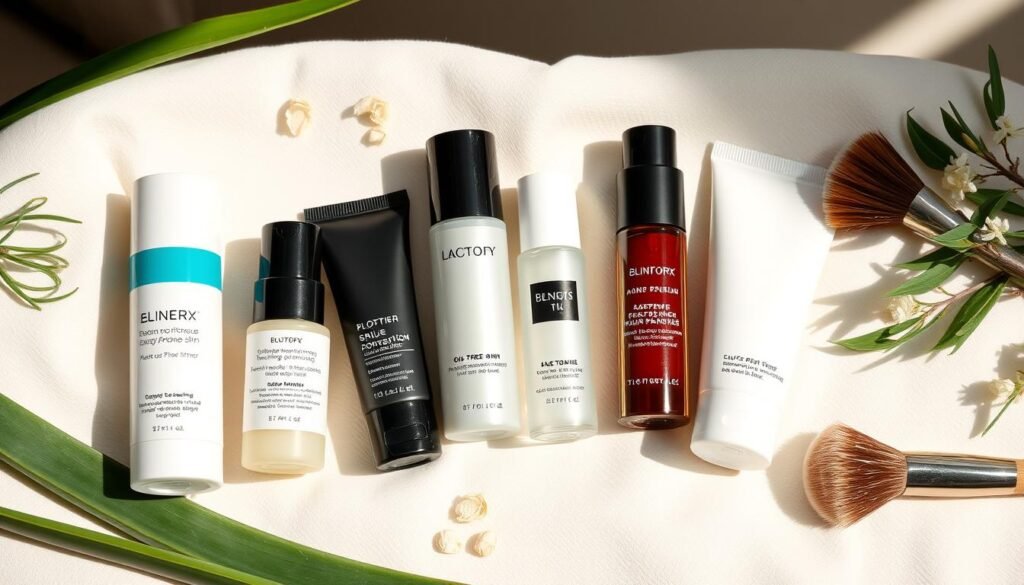
For more information on how to choose the right primer for your skin, consider the following table:
| Primer Type | Benefits | Drawbacks |
|---|---|---|
| Silicone-based | Long-lasting, smooth finish | Can be heavy, pore-clogging |
| Water-based | Lightweight, non-comedogenic | May not last as long |
Combining Primer with Other Acne Treatments
Using a non-comedogenic makeup primer can be a great addition to your skincare routine. It helps create a smooth canvas for makeup, reduces pore appearance, and controls shine. To get the most out of your primer, combining it with other acne treatments is key.
Layering products in the right order is crucial. Start with a gentle cleanser, followed by a spot treatment for active breakouts. Then, apply a non-comedogenic makeup primer to smooth out your skin. Make sure to choose a primer that is labeled as “non-comedogenic” or “oil-free” to avoid clogged pores.
Timing Your Skincare and Primer Application
Timing is everything when applying skincare products and primer. Allow each product to absorb fully before applying the next one. This prevents clogged pores and ensures each product works effectively. For example, apply a spot treatment and let it dry before applying primer.
Product Compatibility Considerations
When combining primer with other acne treatments, product compatibility is key. Look for products labeled as “non-comedogenic” or “acne-friendly” to avoid clogged pores. Avoid harsh ingredients like sulfates or artificial fragrances, as they can irritate the skin and worsen acne.
By following these tips and using a non-comedogenic makeup primer, you can achieve a smooth, acne-free complexion. Always choose products that match your skin type and concerns. Don’t be afraid to experiment until you find the right combination that works for you.
Tips for Selecting the Right Primer Formula
Choosing the right makeup primer for acne-prone skin is key. Look for products that say “non-comedogenic” or “oil-free.” These are less likely to block pores and make acne worse.
Key ingredients to look for include salicylic acid, tea tree oil, and hyaluronic acid. They help control acne, reduce swelling, and keep the skin hydrated. Also, choose a primer with a lightweight, matte finish. This helps hide pores and acne.
- Look for products with soothing ingredients, such as aloe vera or chamomile, to help calm and comfort the skin.
- Choose a primer that is fragrance-free to reduce the risk of irritation and allergic reactions.
- Consider a primer with SPF to provide additional protection against the sun’s UV rays.
By researching and understanding your skin’s needs, you can find a primer that works well. It should help your makeup look smooth and even while keeping your skin healthy. Learning how to choose the right primer can greatly improve your skin’s appearance and health.
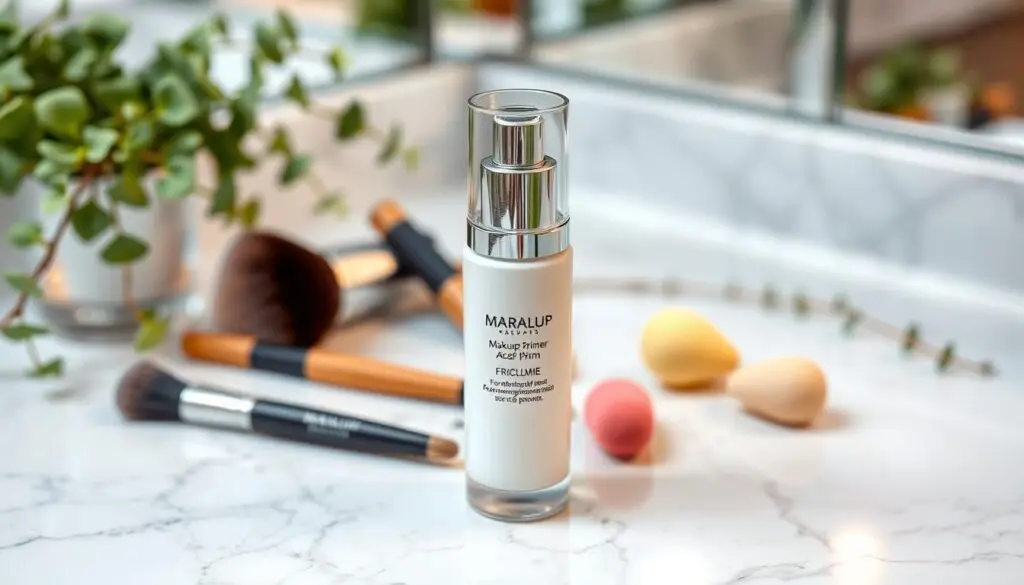
Conclusion: Making Primer Work for Your Acne-Prone Skin
Using a makeup primer can be good for acne-prone skin, but you need to choose wisely. Look for acne-friendly primer formulas that don’t clog pores and have ingredients that calm the skin. This way, you can avoid breakouts and still have smooth, lasting makeup.
Every skin is different, so finding the right primer for your “should i use makeup primer if i have acne” needs might take time. Be patient and listen to your skin. With the right primer, you can make it a part of your acne-fighting routine.
FAQ
Should I use makeup primer if I have acne?
Using makeup primer on acne-prone skin is a bit tricky. Primers can smooth the skin and help makeup stay in place. But, they might clog pores and make acne worse in some cases. It’s key to pick a primer that suits your skin well.
What is makeup primer and how does it interact with acne-prone skin?
Makeup primer is applied before foundation to make the skin smoother. But, some primers can block pores and cause acne in sensitive skin.
What are the benefits of using primer on acne-prone skin?
The right primer can help acne-prone skin in many ways. It can make pores less visible, control shine, and provide a smooth base for makeup. It also acts as a barrier between the skin and makeup, which might help reduce acne impact.
What are the potential risks and considerations for acne sufferers when using primer?
The biggest risk of using primer on acne-prone skin is clogged pores and worse breakouts. Avoid primers with oils, heavy creams, and silicones. If you notice more breakouts, shine, or skin feeling heavy, it’s not working for you.
How do I choose a makeup primer that is safe for acne-prone skin?
For acne-prone skin, choose primers that are non-comedogenic and oil-free. Look for soothing ingredients like aloe vera or green tea. Avoid heavy silicones and fragrances. Always patch test a new primer before using it on your face.
What are the key ingredients to look for in an acne-safe primer?
For acne-prone skin, look for primers with niacinamide, salicylic acid, and hyaluronic acid. Stay away from oils, silicones, and heavy creams. Opt for non-comedogenic, oil-free formulas and consider primers with aloe vera or green tea.
How should I apply primer on acne-prone skin?
Apply primer lightly, focusing on areas like the T-zone or nose. Don’t rub too hard, as it can irritate your skin. Let the primer absorb fully before applying foundation or makeup.
How can I effectively combine primer with other acne treatments?
When using primer with other acne treatments, apply them carefully. Put on acne-fighting serums first, then primer and makeup. Be careful not to use too many heavy products, as they can clog pores.
What tips can you share for selecting the right primer formula for acne-prone skin?
For acne-prone skin, choose oil-free, non-comedogenic primers made for sensitive skin. Consider what your skin needs, like controlling shine or minimizing pores. Always patch test a new primer before using it on your face.

